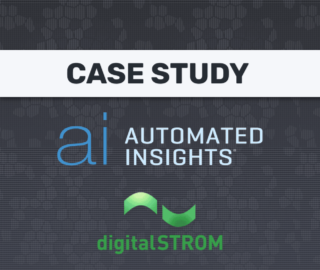
Technology Provider: Albert – An artificial intelligence marketing platform for the enterprise, driving autonomous digital marketing campaigns for companies around the globe
User Company: Cosabella – An Italian lingerie company.
Industry: Consumer Goods
Application: Marketing / Advertising
Problem
Cosabella realized that investing in manual efforts in marketing and advertising was not scalable or cost-effective. The company wanted to automate marketing rather than rely on traditional marketing/advertising agencies.
It’s decision to find an artificial intelligence vendor was part of Cosabella’s own 3-year business transformation strategy. Albert claims that Cosabella aimed to find a marketing strategy that would scale without needing to scale it’s related marketing staff. Cosabella’s former CMO, Courtney Connell was tasked with overhauling the firm’s marketing efforts, and chose Albert as it’s partner.
Actions Taken
Cosabella hired Albert to do two things:
- Identify and convert high-potential shoppers that were most likely to become buyers
- Improve efficiency and effectiveness of paid search and social media marketing efforts
Albert states that their software required integration to the Google Analytics accounts and online ad accounts (Facebook, Adwords) of Cosabella.
Cosabella then provided Albert with the creative ad copy and visuals and a set of KPIs needed for it to execute digital marketing efforts. Albert identified user behavior and patterns across paid search and social media for Cosabella, such as browsing and purchase patterns, choice of devices used for purchases, etc. It then analyzed these behavior patterns to:
- Offer “proactive” insights and recommendations on creative and messaging. This essentially means that Albert provided useful insights that required human authorization, such as: budget optimization, adding a specific channel to an existing campaign, adding new creatives, fine-tuning messaging to customers that might increase user interest and engagement, etc.
- Run micro-campaigns to test, identify, and optimize high-performing purchase patterns based on several campaign variables. These variables include customer demographics (age, gender, etc.) and interests (choice of model or color), testing out various creative and headline combinations across marketing channels, and identifying users’ primary choice of channels and devices like laptop, mobile and tablets.
- Carry out autonomous media buying using predictive analytics and deep learning technologies, which Albert claims involves “little to no human interaction or supervision.” This essentially means that Albert could autonomously negotiate price and placement for advertisements by predicting high-potential buyers.
- When asked about the respective roles of man and machines in online bidding, an Albert spokesperson provided the following response: “Humans have control over budget (e.g., spend $20K/month) but not over ad spend (e.g., spend $1K on that specific Facebook ad).”
Albert CMO Amy Inlow states:
When setting up a campaign, clients have the option to choose from known user segments (e.g., those from their own database/CRM and their own site visitors), to go after lookalikes, or to create totally new audiences. When the client chooses “new,” the client is asking Albert to find new ones.
Albert states that clients provide KPIs and high-level parameters (as well as known high-value audience specifications), and Albert works to run campaigns to known audiences and identify new potentially high-value audiences.
These new audience segment ideas are presented to a client for feedback on their viability, and Albert claims that client feedback is used by the system to further fine tune the parameters for new audiences (what it calls “look-alike testing with micro-audiences” – which implies exploring small, related groups to the original high-value known audience groups that a client provides. An Albert representative goes into a bit more detail:
Albert often provides insights and suggestions to the client regarding how to alter campaign creative and other variables that are under their control (such as new channels to target). Assuming these suggestions support their high-level goals and are in keeping with their investment limitations, the client will often adjust campaign parameters (such as customer demographics and destination channels) to Albert’s learnings, leading to a wider reach and the identification of many more high potential leads.
It isn’t clear exactly what interface is used for this man-to-machine communication, or which aspects of the process are also aided by Albert’s human team, and not simply the AI system.
Results
Albert claims that, in the first month of its integration with Cosabella, it reduced Cosabella’s overall ad spend by 12%, while increasing the return on ad spend (ROAS: amount of revenue a company receives for every dollar spent on an advertising source) by 50% across paid search and social, with Facebook seeing a 565% increase in ROAS.
It isn’t clear whether or not Cosabella was spending any significant amount of money on Facebook before it’s use of Albert (i.e. If the firm was spending only tiny sums of money “tinkering” on Facebook ads, then a massive life in ROI is less significant than if the firm was already running profitable campaigns and spending tens of thousands or hundreds of thousands of dollars per month). We weren’t able to learn the before and after spend volume for this case study.
Albert also reports that, by the third month, the ROAS for Cosabella increased by 336%. Further, Albert states that, after its integration, the contribution of social media to Cosabella’s total paid ad revenue increased to 30% from 5-10%, with a 2000% increase in purchases (transactions generated from social) originating from Facebook in particular.
An Albert representative was able to add more detail about the relative value of social advertising before and after Albert:
Before Albert, Cosabella’s social was “unstable”, meaning that they could inconsistently expect approximately 5-10% of paid ad revenue to result from their social investment. In Q4 – paid revenue from social media increased to 15%, as a result of Albert’s social refresh strategy (a two-week “quick start” where we added new content on top of their high-level social campaigns). Now, social is contributing 30% of [Cosabella’s] overall paid revenue, consistently.
Albert’s work in just Q4 contributed to the company’s 50% year-over-year increase in overall ROAS, according to an Albert representative. This success reportedly represents a 37% increase in overall website sessions, a 30% increase in new users (visitors to Cosabella’s site), and 1,500 more transactions (purchases).
Transferable Lessons
Cosabella’s motive to use Albert (scaling their process, without scaling their staff) is a common value proposition of AI-based tools. While many business functions (marketing included) are still in the phase of experimenting with AI, as time processes we can suspect that the barriers to entry for AI tool use will decrease (importantly, the data science expertise needed to successfully use such systems).
As AI gains more tangible footholds in business – and becomes a required and somewhat easy-to-use staple of processes like marketing, business intelligence, data security, and more – we can expect more and more businesses to be drawn to the appeal of scaling process (productive ability) without scaling staff (expenses).







